|
|
Post by seeshell on Apr 13, 2012 21:38:03 GMT 10
Good Evening All We're very fortunate that the Conrick family have found a few more photos - one is of the Blue Flyer and Swish the Boat, and the others are of another van that was made by Arthur Conrick. The Blue Flyer at Lake Conjola in 1962-1963 (with Swish his handmade boat in the background) 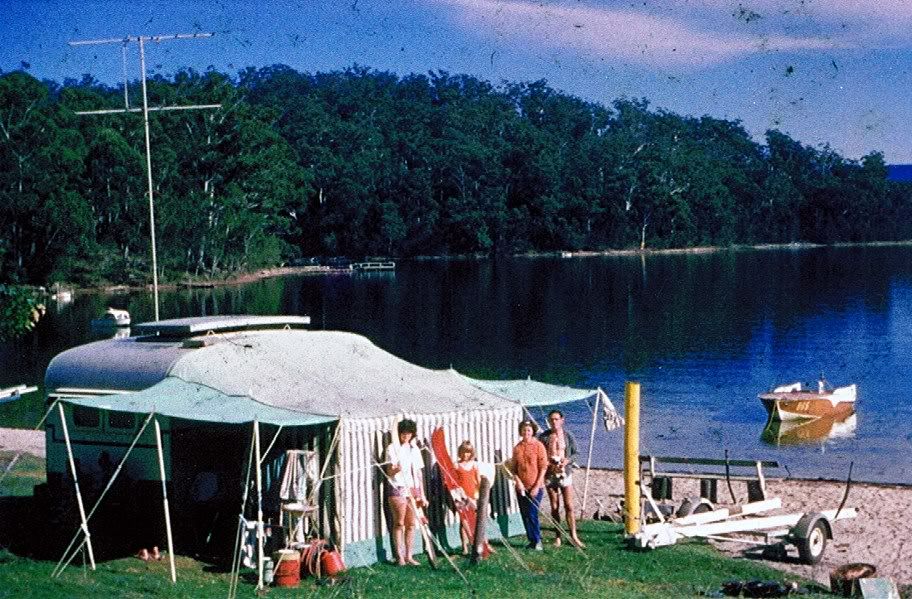 ' Arthur Conrick's other van - homemade metal 1952 with the kids sitting in the frame  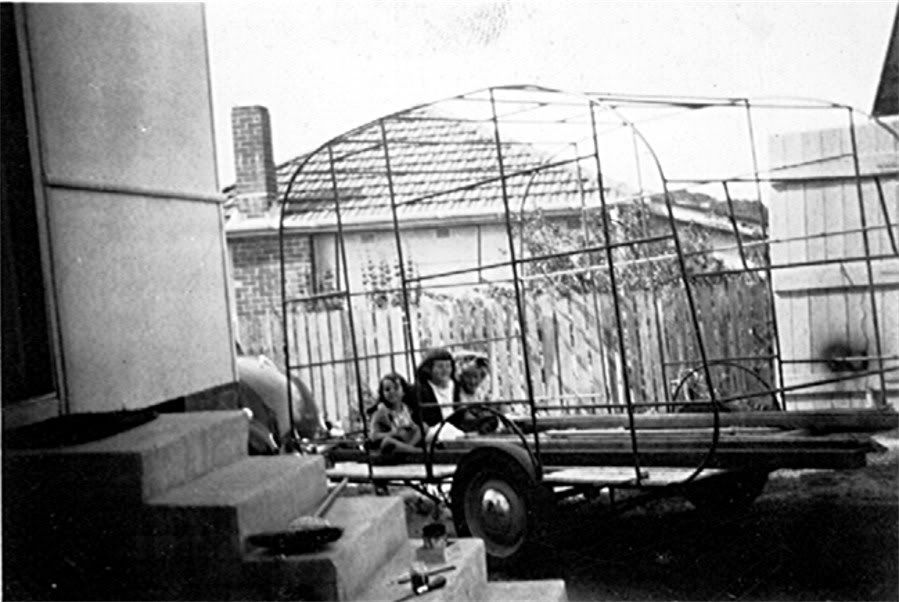 Arthur part way through the construction of the smaller metal framed van 1952 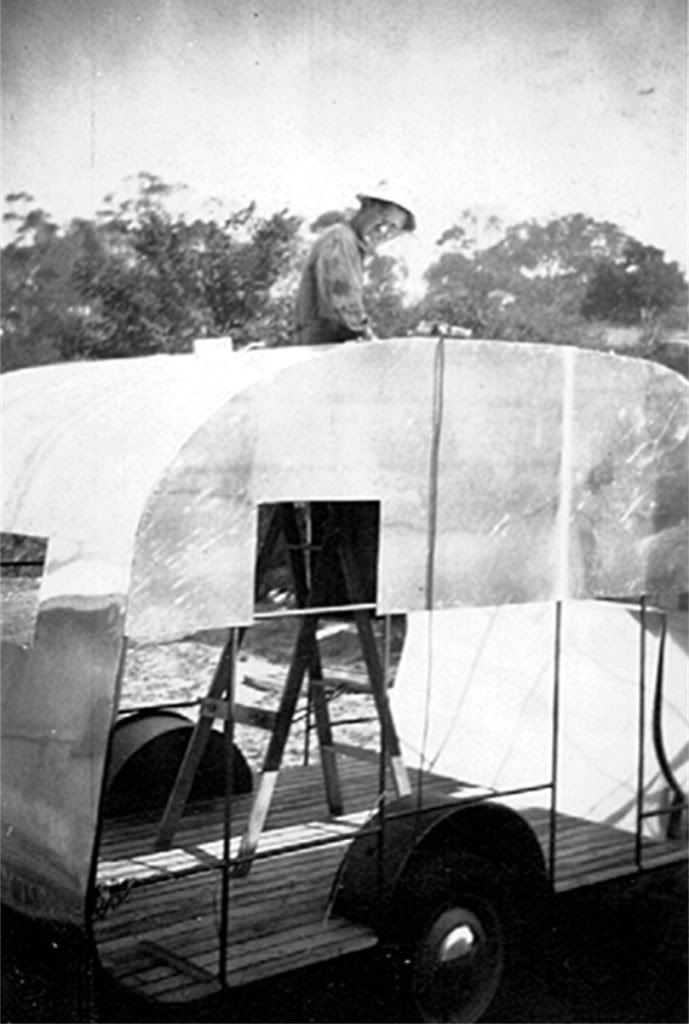 Arthur in the finished shell of the smaller metal van 1952 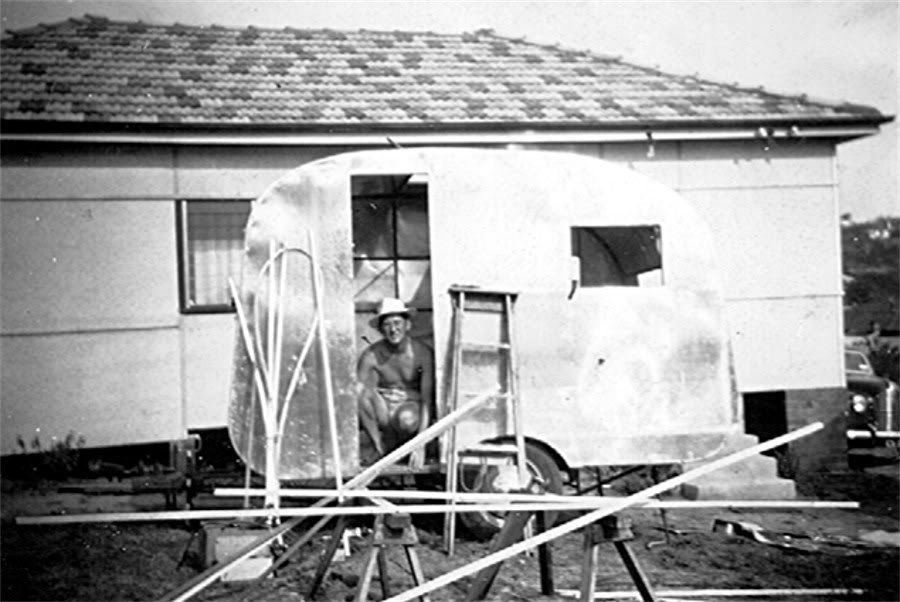 Lovely to have more photos of Arthur's constructions - again, great thanks given to the Conrick family for sharing their photos. Cheers, Seeshell |
|
|
|
Post by hilldweller on Apr 14, 2012 10:34:05 GMT 10
That first pic of the family holiday is just lovely! Do you know what happened to the van in the second set of pics?
|
|
|
|
Post by seeshell on Apr 14, 2012 10:46:26 GMT 10
Hi Hilldweller
I've asked about the fate of the other van, but as yet haven't heard back.
Cheers
Seeshell
|
|
|
|
Post by megann on Apr 14, 2012 13:33:59 GMT 10
Awesome photos Seashell!! So did Arthur only make the two homemades?? clever bloke! Would they have come in a kit or was it a case of sourcing your own materials and starting from scratch??
Megan
|
|
|
|
Post by seeshell on Apr 14, 2012 13:40:07 GMT 10
Hi Megann
Arthur made two boats and two caravans and a host of other things, as his daughter Kate and wife Noelene tell it.
I know he did use a plan from Popular Mechanics to make the boat Swish, but apparently the rest of the constructions were all out of his imagination.
His other van - the metal one - was done in 1952 which I would have thought was fairly early for an aluminium van (bondwood seemed to be the go at the time). He was quite advanced with many of his features, including the gas and 240v fridge in the Blue Flyer installed in 1950 when many still had iceboxes.
Pretty clever guy, and certainly he was a very good craftsman (even if the wiring left something to be desired)!
Cheers
Seeshell
|
|
|
|
Post by DC3Td on Apr 14, 2012 22:03:22 GMT 10
Hi Seeshell. Great to see these old build pics.By the way,PM sent. cheers gordon
|
|
|
|
Post by Roehm3108 on Apr 15, 2012 7:34:06 GMT 10
Hi seeshell
The way that paint is coming off makes one wonder if there isn't some sort of sealer on that ply that doesn't like holding paint. Wonder if it isn't worth checking with a paint company whether some other sealer isn't needed (rather than a primer/sealer/undercoat). Am thinking of something like ESP which you use when painting laminated surfaces and requires an enamel paint finish.
Would hate for you all to be going to such great lengths only to have the paint fail again.
Ray
|
|
|
|
Post by seeshell on Apr 15, 2012 8:49:04 GMT 10
Hi Ray Yes we've got a few test patches to do I think before we go the whole hog! That's good advice - I'm not sure why the paint sheeted off, but it could be that: - Because the top coat was acrylic, there was insufficient prep taking off the under enamel layer.
- It was painted in the sun, or when the body of the van was too warm, and the paint skinned underneath before it could adhere to the wood.
- No undercoat was used.
I'm not sure at this point if it isn't a bit of ALL of the above.  We are going to do a bit more removal of fine traces of paint and then do tests - we have an enamel filler primer, but I might get some of the ESP to try as well. Then when dry, I'm going to attack each square and see what happens.  Appreciate the steer, Seeshell |
|
|
|
Post by cobber on Apr 15, 2012 13:46:05 GMT 10
G'day seeshell 'n Ray, Now.... I don't know because I've never seen it but...... when I hear of paint coming of in sheets...and it has been mentioned a few times on the forum.... I wonder if we are dealing with "Rescote", you know..."Reswood" with a plastic coating that has then been painted. I don't know how the plastic coating would react to paint stripper  but I can't imagine it would be possible to take the paint off without disturbing the plastic and then it would all come off in big and little sheets. What does somebody who really knows reckon......aye?   Cobber. |
|
|
|
Post by seeshell on Apr 15, 2012 14:12:01 GMT 10
Hi Cobber In response to your post of April 1 on the topic, on the thread I wondered: When did Rescote start up? Just wondering if he would have had access to it at the time. There doesn't appear to be a coating, or nothing I can feel - not waxy, smooth or glossy in any way. Was it a solid coating, or more a penetrating product? Cobber, do you have any other information that might shed some light before I go to town on the old girl in two weeks time? I'm NOT keen to repeat the experience!  Thanks for any pointers! Seeshell |
|
|
|
Post by seeshell on Apr 15, 2012 17:11:56 GMT 10
Hi All I have heard from the Conrick family again - and they have shared another interesting photograph. This one is not about the van, it's about the boat, Swish. Apparently they were holidaying at St George's Basin (in they think 1965) and had Swish tied up at the dock. In one of those "what are the odds" moments, another family holidaying saw their boat and pulled up to visit with them. They'd worked to the same plans out of the US magazine Popular Mechanics in the mid 1950s.. 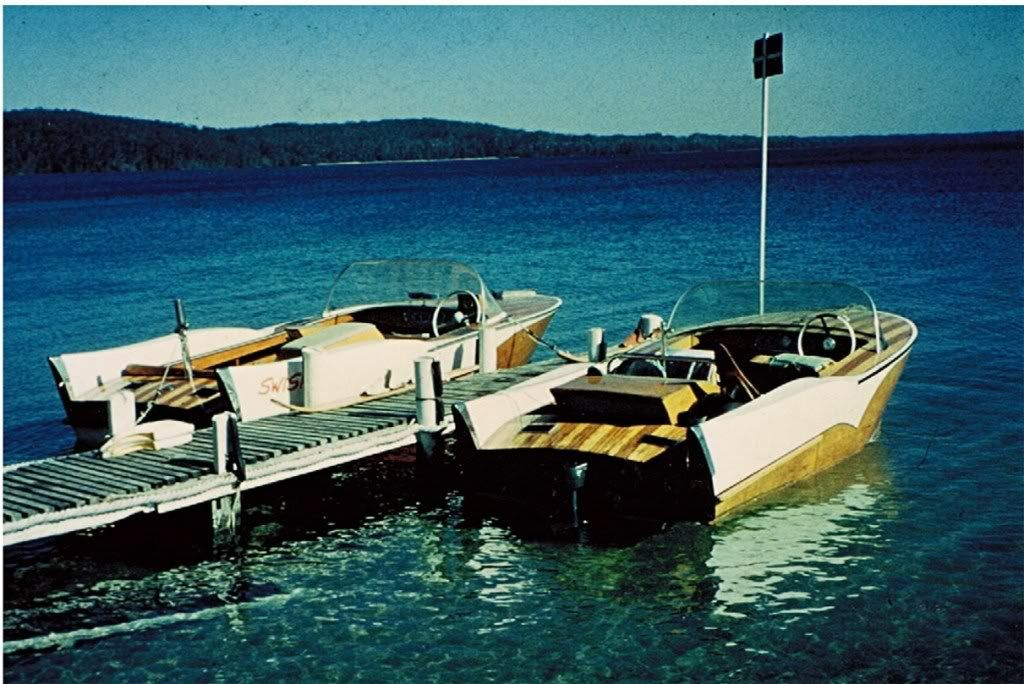 1,000,000 to 1? Seeshell |
|
|
|
Post by Franklin1 on Apr 15, 2012 19:59:51 GMT 10
G'day seeshell,
Rescote seems to have started in the new factory that Ralph Symonds built in Homebush, Sydney, and which opened in November 1959. The business had actually started in 1942 and was manufacturing waterproof plywood for many years after that, but I don't think the Rescote product was available until about 1960.
When you say the paint was lifting in large sheets, do you mean it was lifting in one lot directly off the plywood base, or was there still some coats of paint left behind after the big sheets came off? The reason I ask is because I was stripping paint off some second hand timber today with a hot air gun, and the top couple of layers were coming off easily in long strips, but the layers underneath needed some additional coaxing with the gun and scraper to remove. The layer closest to the timber was particularly difficult to remove, so whatever type of paint it was, it sure gripped onto the timber!
cheers,
Al.
|
|
|
|
Post by humpyboy on Apr 15, 2012 20:46:27 GMT 10
The reason I ask is because I was stripping paint off some second hand timber today with a hot air gun, and the top couple of layers were coming off easily in long strips, but the layers underneath needed some additional coaxing with the gun and scraper to remove. The layer closest to the timber was particularly difficult to remove, so whatever type of paint it was, it sure gripped onto the timber! cheers, Al. Hi AL, my guess on why the last few layers of paint were harder to remove is because it was more than likely lead based. |
|
|
|
Post by cobber on Apr 15, 2012 20:53:53 GMT 10
Seeshell 'n Al, I'm just getting the info together but I have found "Reswood" was first advertised in May 1947 and "Plasply" first in November 1948. "Plasply" would have been a plastic covered "Reswood" The first "Rescote" was a fire retardant paint applied to "Reswood" in 1952.... the first mention of "Rescote" being a plastic coating appeared in 1959. That info comes from "Trove" searches but any of the above could have been in use before Ralph Symonds started advertising it's availability.... more searching required  Cobber. |
|
|
|
Post by Roehm3108 on Apr 15, 2012 21:22:32 GMT 10
Hi cobber I hear what you're saying. But I doubt that anyone on the forum would be prepared to stick their neck out with a definitive opinion without actually seeing the timber. Even then, it would still be worthwhile to have it tested to determine IF, in fact there is a problem about painting straight over the bare timber with a quality PSU and then topcoating it. This is why I suggested going to a manufacturer. I find it interesting that only some of the walls seem to have that "oily" surface, while others seem to be OK. Perhaps the latter are replacement panels??? I used ESP on laminate surfaces and that bound the final paint very well, so if there is some sort of plastic coating on those panels, I reckon that the ESP would do the job. The downside is that you HAVE to use enamel paint to finish, which you, seeshell, may not want. Seeshell, I know you're racing against time, but why not test a section of the wall with PSU, give it a couple of days to dry properly and then try the sticky tape test? If the tape doesn't lift the PSU when you take it off, then I would be inclined to take the chance and presume it's OK and will hold. The alternative is that you take the van to Cowra "as is" and let all attenders there give their "expert" opinions, before painting it ;D ;D ;D       |
|
|
|
Post by Franklin1 on Apr 15, 2012 21:46:54 GMT 10
G'day Ray, You missed some crucial info while you were travelling in outback SA recently. No Cowra for seeshell. Plug has been pulled. A few posts back in this thread somewhere.   Edit: Nup, it's in the Nationals thread. cheers, Al. |
|
|
|
Post by seeshell on Apr 15, 2012 22:54:47 GMT 10
Hi Al, Cobber and Ray, *warning* longish, paint-related postThe ply has the same faint red colour all over (but not on the inside). However only part of the van's paint did it come off in dinner plate sized sheets when heat was applied: the front and doorhand side back half. The back and far side were more difficult to strip to wood and only came off in 50 cent pieces even with heat (I did the back, and my father in law took pity and did the other side while I was at work). The whole van has now been sanded with 60 grit, 240 grit, and in some areas 400 (smoothing an old repair), by machine and by hand. At the time everything went south, I didn't think to look for telltale signs or residue. To be honest I was still focused on how we could clean up, sand back and get colour back on. The full enormity hadn't hit, real 'Scott in the Antarctic' stuff: "Yes, old chaps...we'll make the Pole on schedule. Are we dressing for dinner this evening? What do you mean we have to eat the dogs?"  Back to the paint: Back to the paint: In the really bad areas: when the paint was cold, I could peel small pieces off (smaller than the size of your palm). But if I heated an area the size of a dinner plate to a light sizzle (small bubbles all over) and let it cool to just touchable without being burnt (a very specific temperature that is QUITE hard to achieve!), I could sheet it off like you saw. Just as easy as peeling off a low tack sticker. IN both cases when it came off (cold or warm) the whole lot came off - nothing remained behind to be worked at. Back to wood. But as I say, not all the van was that easy. Now I know that the van has been White, Cream, Green, Dark Blue and Light Blue because I have pictures or have been told that. However there was only cream paint to be found under the paint, and faint traces of a darker blue. No green, no white. This makes me think that it's been stripped to wood at least once - and quite comprehensively. If so: a. if there was a coating and the van had been stripped multiple times, could it already be gone? If so, is this is just a bad paint job? Like painting it outside in the sun or something, drying too fast? Not cleaning all the paint stripper off (if they used chemicals?) b. if there is no longer a coating (or never was), is it a paint failure rather than a residue issue? Say using acrylic over enamel without the right prep? There is cream on the back of the blue paint (which you can see in the first of the 'Oh Bugger' pictures), and wondered if that might be primer, but the wrong sort? c. If it isn't the paint or prep, was the ply coated in some other product and that is why the paint didn't adhere? Maybe it's red oxide, and I shouldn't have been licking my fingers to cool them off...  (kidding) Could be marine primer (see Swish the boat), or something like bondcrete which only takes a certain kind of paint? Could be some other as unknown treatment. Could be remnants of Rescote (either plastic paint or coating). It's only two weeks until my time off, and I want to have and attack plan. I need to get/order whatever products, tools, and other implements are required to go at it hard. Ok gents, time to talk turkey. I am painting both the filler/primer and colour in 2pac which is a modified enamel paint if that helps. I need to test for waxiness or some sort of sheeting ability of the ply (the coating). How should this be done? Result A: Nothing detected. Situation Solvered! Result B: Something there, determine what it is and remove or deal with it. OR I can just dip the whole thing in Boat-Cote. Al's loving it... Ideas on what you would try, in what order? How would you test? If there is something, how can I know what will cover or remove it? And I still want to do the roof over....might have to plan carefully! Open to anyone who has some sage advice, Seeshell |
|
|
|
Post by cobber on Apr 16, 2012 7:49:59 GMT 10
G'day seeshell  What I would be doing if I was you is....what I did recently, get in touch with the people who make the paint you intend using. I've been playing with a van that was originally prepared using red lead primer which..... after removing the paint... looked a lot like the "swamp van" that I'm pretty sure was built using "Reswood". Anyway..... in both instances I got technical advice from the blokes at "Duralex Paints"...who make the paint I use, in the first instance with the "Swamp Van" they told me to just slap paint over the timber, no undercoat required. With the van previously painted with Red Lead, that had lots of slot headed screws holding the ply to the frame, they said to play it safe it would be smart to use an oil based primer under their water based acrylic paint.... not because of the Red Lead but because of the screws. I find the people who make the paint want to protect the reputation of their product so they give good advice but .... there will be blokes on this forum who know a bit about two pack paint too. Me ?..... don't know nothing about two pack   Cobber. |
|
|
|
Post by kaybee on Apr 16, 2012 8:06:02 GMT 10
Hi Seeshell , just wondering if you've used 2k paints before?
|
|
|
|
Post by Roehm3108 on Apr 16, 2012 8:17:28 GMT 10
Oh seeshell   Painting your van in 2pac   What would the builder say    ;D ;D ;D You're treading into a field (one of many!!) in which I am an illiterate   Personally, I would be talking to the paint manufacturers. They may have some sort of testing method or chemical you can use to ease your mind. Surely this problem has been encountered before, and they may already have a solution, such as a sealer, that will make sure there is no problem with paint adherence. Ray |
|
|
|
Post by Roehm3108 on Apr 16, 2012 8:22:16 GMT 10
Hi Seeshell , just wondering if you've used 2k paints before? Now I wonder why kb would say that    Must know something .................................... |
|
|
|
Post by seeshell on Apr 16, 2012 8:37:32 GMT 10
Hi Kaybee I have used 2pac before - though not for something this large, only touch up repairs on metal and fiberglass. I have got the 2pac primer filler, as well as the top coat. I've got all the right masks to filter out isocyanates (don't' fancy dying) and proper cover suits. We should be well ventilated...we've got an outside spray booth to set up. I've not sprayed on wood before, so I am planning some testing on ply before I get underway. I don't mind too much if the result isn't perfect - just like the shine similar to oil house paint with a bit more durability. But at this rate, I might never paint though.  If you have any tips, I would welcome it. Thanks Seeshell |
|
|
|
Post by kaybee on Apr 16, 2012 10:04:16 GMT 10
If you have any tips, I would welcome it. Thanks Seeshell ....I don't know if you'd call this a tip ,but if I was going to 2k something as large as a caravan , I'd do the primer coats and rub them out in preparation for the topcoat ,then I'd find someone who specializes in painting truck bodies and have them do the colouring in. 2k is tricky stuff to paint , hazardous issues aside, it has to go on wet enough to flow out and also not get dry spray patterns in it ,it doesn't "flash off" very quickly so it has a tendency to sag and run....2k professionals know just how far you can go with buildup before it all falls on the ground ;D....I've been painting classic era cars for near on 40 years but in Acrylic Laquer so I've got some experience in the paint area....and I wouldn't do it  ....but that's just me! But if you do it and muck it up, it's going to be real tough going to sort it out. Once properly cured it's a very hard surface , if you have to sand out runs or other blemishes you'll find out just how hard it gets, and you can't do spot repairs either....you have to do the whole panel again .....so give it some careful thought and good luck with whatever you decide  |
|
|
|
Post by seeshell on Apr 16, 2012 10:23:46 GMT 10
Hi Kaybee
I might just do that - do the primer, rub back, etc and give them the top colour paint.
I'm liking your idea more and more.
Cheers
Seeshell
|
|
|
|
Post by geeza67 on Apr 29, 2012 19:26:19 GMT 10
Hi Carley. Love your van! Also love the bunk for your daughter. Just as you described it to me. Cheers, Chris.
|
|